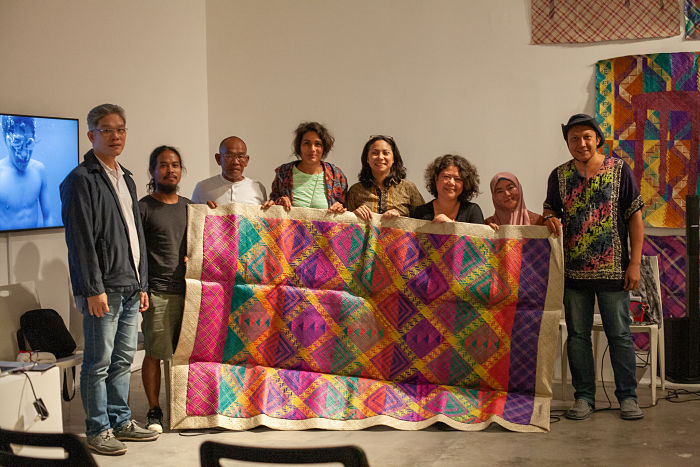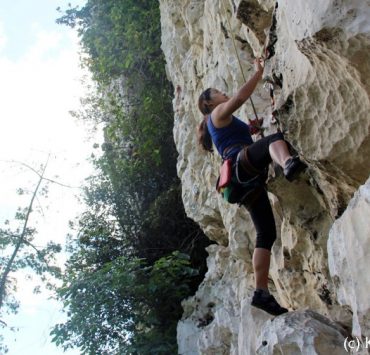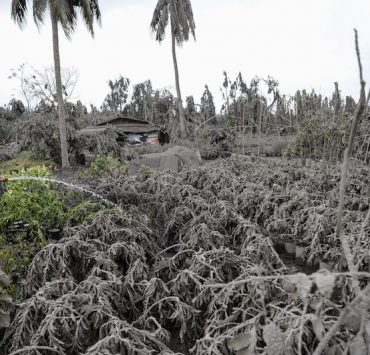With the way many kinds of artworks are upheld and given such a privileged role in society today, I’ve always been a firm believer that art can’t afford to not say something meaningful or inspire people to do better. Then again, art these days tend to seem obscure and mysterious to the point where it can be hard to decode what it’s trying to imply—that is, on their own. This is where interpreters, curators, aesthetics professors and even artists themselves come in to give a sense of where an artwork is coming from and what they’re trying to say.
So it wasn’t a surprise to find myself thrilled to be at Silverlens Galleries’ art symposium Local Matters: Martha Atienza and Yee I-Lann on Communities, the Environment, and Art last Jan. 11. The discussion was in conjunction with both artists’ exhibitions namely Martha’s “Equation of State” and Yee’s “ZIGAZIG ah!” The two artists along with their team discussed how they are using their respective art forms to tackle, redirect attention, and, ultimately, come up with concrete solutions to the social and environmental issues of their communities.
On Martha Atienza’s “Equation of State”
Dutch-Filipino artist Martha Atienza’s “Equation of the State” centers around the documentation of the current state of the Bantayan island in Cebu where she grew up in. The preview that I watched for her exhibit was a three-channel video piece of individual fishermen and divers in and out of the seawater. Each one going through the phases of the sea, almost swallowing them up or the fishermen drifting away along with it at different intervals.
https://www.instagram.com/p/B6PcslJlIFl/
This is admittedly Atienza’s allegory to the fishermen’s constant struggle in rough waters and changing times just to provide for their families. It is an effective one at that as just watching the Three-minute clip literally made me feel breathless at the thought of being in their position along with the anxiety that comes with the endless cycle of desperately keeping your head above water.
The main piece was a slowed down, single-channel video Panangatan 11°09’53.3″N 123°42’40.5″E 2019-10-24 Thu 6:42 AM PST 1.29 meters High Tide 2019-10-12 Sat 10:26 AM PST 1.40 meters High Tide, which was a documentation of Bantayan Island’s coast showing glimpses of the local’s churches, boats, houses, and even some of the residents going about their day-to-day lives.

The atmosphere of the video was dark and eerie to say the least due to the fact that you could also see how things were either on the verge of being overcome by the rising sea levels or are on their way to decay for a handful of reasons. One of which was Super Typhoon Yolanda’s devastation of the island. Nonetheless, the video can also be said to depict the resilience of these structures and its residents.The last part of Atienza’s “Equation of the State” was a set of mangrove plants whose roots were mechanically manipulated to be submerged in water at different intervals.
https://www.instagram.com/p/B6PcslJlIFl/
Atienza’s obsession with mangroves to the extent of displaying it as an art piece stems from the shrub being a possible solution to the effects of climate change. Mangroves are known to store CO2 emissions and greenhouse gases, consequently being able to reduce these damaging gases’ presence in the atmosphere. Moreover, the mechanical motion, which regulates the plants’ growth, represents and emphasizes the necessity of man-made intervention in order for these kinds of solutions to thrive.
https://www.instagram.com/p/B7IBvvYlJ2q/
The video camera as a microphone
Atienza’s work was a haunting experience that embedded ponderings about the islanders’ way of living and how they’ve dealt with a degenerating environment. The artist is fully aware of how the product of video documentation using the right angles and conditions can condition people to see things from a broader perspective. She figuratively describes it as “using the video camera as a microphone” in the sense of letting the issues speak for themselves.
“If the guys [fishermen] could just see how they are at sea, they’d be proud of what they’re doing,” says Atienza.
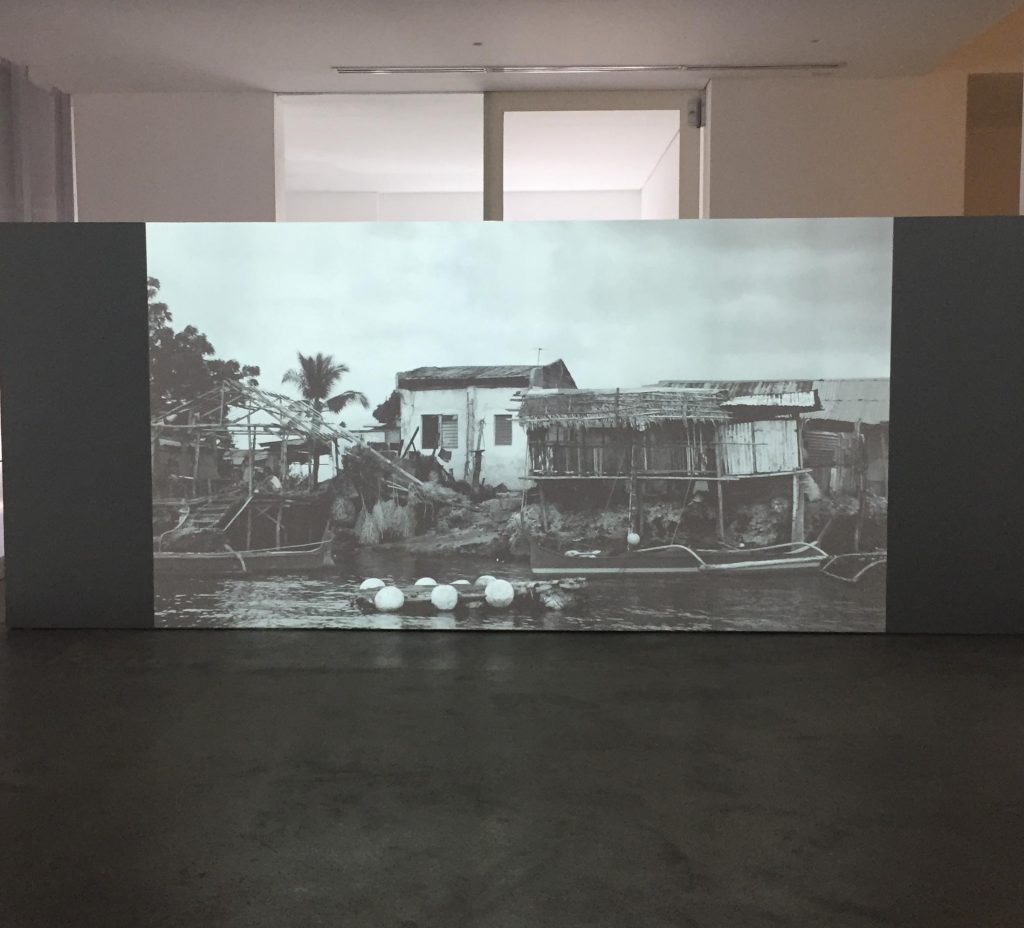
The voice which Atienza’s process develops, however, is not only for spectators like us; she, alongside her team, says that their struggle to organize the island’s residents after Super Typhoon Yolanda was brought about by their paralyzing dependency on donations and their inactive local government.
In this sense and more importantly, the documentation was also meant for the subjects themselves to recognize their own problems. Atienza’s multi-layered account of their community is ultimately all part of her bigger plan to help them get back on their feet. “If the guys [fishermen] could just see how they are at sea, they’d be proud of what they’re doing.”
On Yee I-Lann’s “Zigazig ah!”
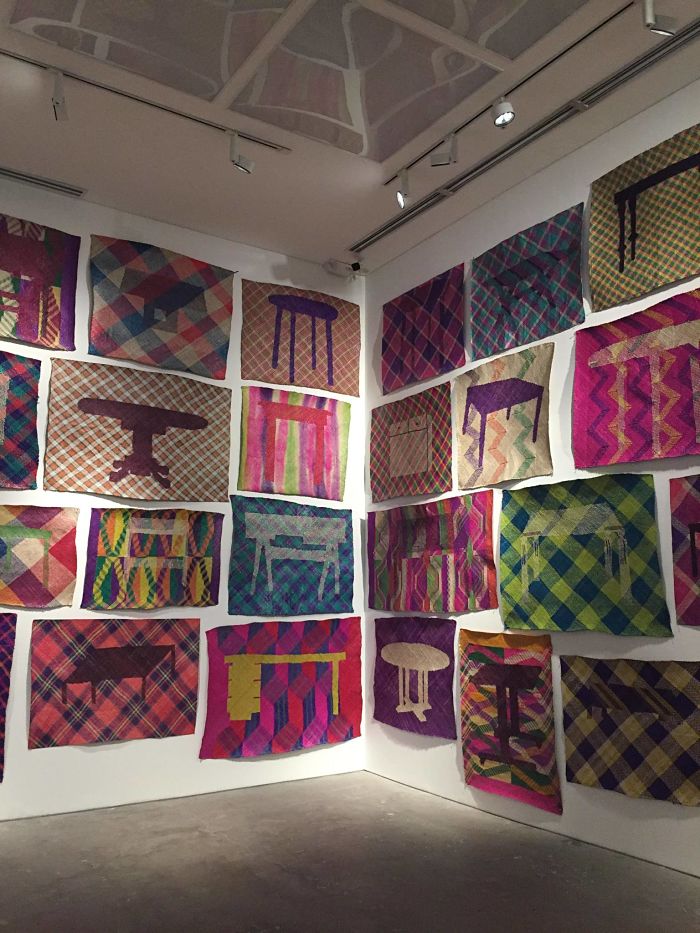
Yee I-Lann’s “Zigazig ah!” was an installation of a variety of multi-colored woven ‘Tikar,’ in Malay which translates to mat in English or banig in Filipino. The contemporary Sabahan artist transforms this traditional everyday object by incorporating her background in photomedia to come up with modern pixelated patterns that, in collaboration with Dusun Murut weavers from a Malaysian tribe in Sabah, are elegantly converted into woven pixels.
https://www.instagram.com/p/B6KrofeF2CW/
Pixels are noticeably language for the modern world and one of her larger pieces actually carry the lines of karaoke favorites including the famous “zigazig ah!” from the Spice Girls’ breakthrough hit “Wannabe,” where the title of the exhibit was derived. The piece looks like one big typewritten banner but, along with the rest of her Tikar designs, is actually a handwoven splitted bamboo mat effectively executed in collaboration with Dusun Murut weavers from Keningau.
https://www.instagram.com/p/B6mgJwdFSVD/
The defining factor of the majority of these mats are evidently the different kinds of superimposed tables in each one. While it’s easy to think that this may just be an arbitrary design, each essentially deserved to be hung on the walls of the gallery for the fact that it was oozing with meaning.
a mat is also where people could literally and figuratively be level with each other. Being on a mat or on the ground with other people is a humbling and communal experience that encourages everyone to feel like equals.
What drew her to creating these mats was the way each piece was “an architectural space that gets unrolled for all kinds of things.” A mat was initially where most Southeast Asian cultures held many of their social gatherings and even daily activities.
With this, I-Lann ingeniously puts forward that a mat is also where people could literally and figuratively be level with each other. Being on a mat or on the ground with other people is a humbling and communal experience that encourages everyone to feel like equals. In contrast to tables, there is no place for a kabisera or principal position and metaphorically, no other structures that divide or encourage hierarchies.
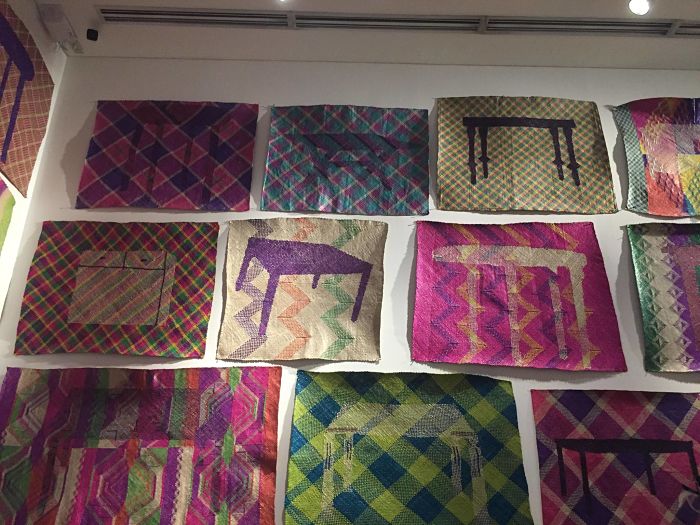
Thus, the tables on the mats represent the patriarchy and the evident power politics that came along with the West’s colonization of Southeast Asian countries. Surveying the mats reveals l-Lann’s exploration of a wide variety of tables for different kinds of purposes like this office table:
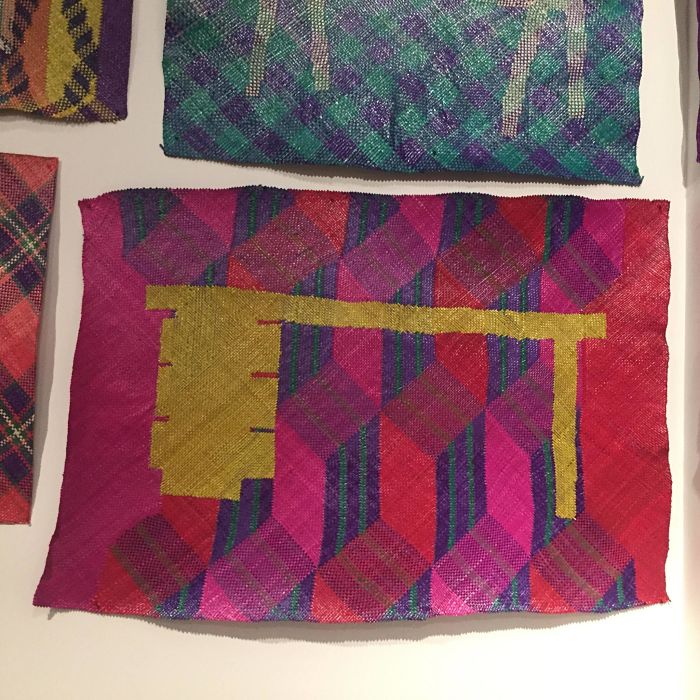
Each type of table subliminally represents a certain kind of power relation we accept but Yee, in her works, makes it clear to put these tables back on the mats and reclaim this aspect of Southeast Asia from colonialism.
‘Exploding the mat’
I-Lann is tremendously passionate about blowing the mat out of proportions that modern civilization usually confines it in or as she calls it ‘exploding the mat.’ Since 2018, she has been teaming up with Kak Roziah Binti Jalalid, community organizer and chairperson of the Women’s Association of Pulau Omadal (WAPO)—a community-based organization that address threats to the marine environment such as destructive fishing practices and pollution—to organize large-scale community weaving projects.
These projects revive their heritage’s craft as a sustainable livelihood that not only brings income to women but stops them from having to go to sea to fish with their husbands. The economic growth and reassurance that this brings to each household, in turn, reduces excessive fishing for the tourist market on their island and lets marine life regenerate.
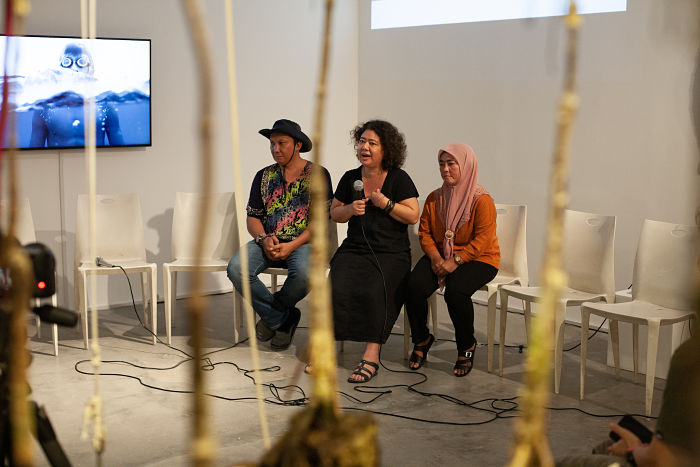
Recently, Yee I-Lann has been in collaboration with Badjao cultural worker and community organizer from Tawi-Tawi, Omarjan Jahuran. Like Yee, Jahuran also wants to preserve their tribe’s way of making high quality mats as well as empower the community through this craft. They both share the aim of making the largest tepoh or banig in the world not only for it to possibly be recorded as such but more importantly, for this democratic space to flourish again.
A universal struggle
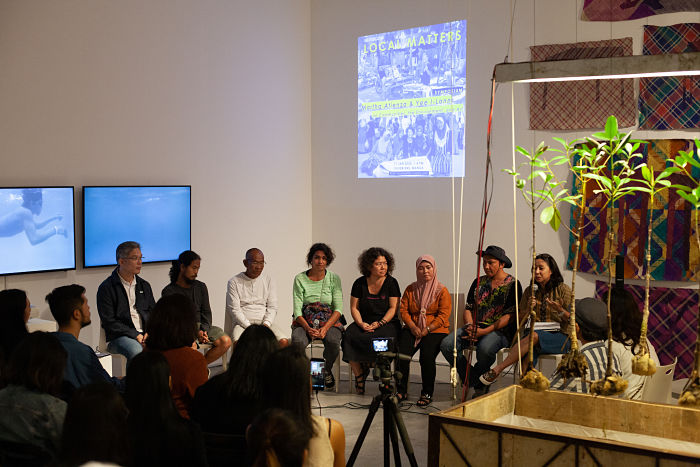
After their dialogues was a joint panel discussion that centered on the evident theme of their artworks: the aim for island community empowerment. In two distinct and remote settings arise the universal struggle of these communities to stay afloat despite the consequences of environmental issues and the threat of modernization.
For the residents of Bantayan Island, this need stems from their lack of solidarity and urgency to overcome the setback of Super Typhoon Yolanda. And in the case of the women of the Bajau Sama Dilaut tribe, it was the difficulty of finding steady means of livelihood given the fact that they= were stateless. The two artists along with the teams they’ve built, however, are a testament to how people can come together and communicate their struggles universally through art.
Although the solutions to these struggles can only be attained through communities working together to lift each other up, this is where collaborations between artists and communities become crucial.
“I can’t think that I myself can make this change,” says Atienza. “You have to work with other people or the community.”
Header photo by Silverlens Galleries
Get more stories like this by subscribing to our weekly newsletter here.
Read more:
This artist from Baguio uses paper art to make a stand about climate change
LOOK: Pinto Art Museum opens its latest and largest wing
How graffiti became an art form
Writer: JOY THERESE GOMEZ
PHOTOGRAPHY SILVERLENS GALLERIES AND JOY THERESE GOMEZ

